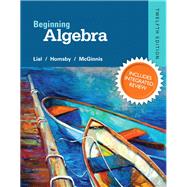NOTE: Before purchasing, check with your instructor to ensure you select the correct ISBN. Several versions of Pearson's MyLab & Mastering products exist for each title, and registrations are not transferable. To register for and use Pearson's MyLab & Mastering products, you may also need a Course ID, which your instructor will provide.
Used books, rentals, and purchases made outside of Pearson
If purchasing or renting from companies other than Pearson, the access codes for Pearson's MyLab & Mastering products may not be included, may be incorrect, or may be previously redeemed. Check with the seller before completing your purchase.
--
This new MyMathLab-based course option from Lial/Hornsby/McGinnis offers a complete intermediate algebra course with embedded review of prerequisite topics from previous courses. The Integrated Review MyMathLab course model can be used to bring underprepared students up to speed, helping to address the challenge of varying skill levels with one seamless MyMathLab course.
Integrated Review MyMathLab courses provide the full suite of supporting resources for the main course content, plus additional assignments and study aids for students who will benefit from remediation. Assignments for the integrated review content are preassigned in MyMathLab, making it easier than ever to create your course!
About Lial/Hornsby/McGinnis’s Beginning Algebra :
Is there anything more beautiful than an “A” in Algebra? Not to the Lial team! Marge Lial, John Hornsby, and Terry McGinnis write their textbooks and accompanying resources with one goal in mind: giving students and teachers all the tools they need to achieve success.
With this revision of the Lial Developmental Algebra Series, the team has further refined the presentation and exercises throughout the text. They offer several exciting new resources for students and teachers that will provide extra help when needed, regardless of the learning environment (traditional, lab-based, hybrid, online)—new study skills activities in the text, an updated and expanded Lial Video Library (available in MyMathLab), and a new accompanying Lial Video Library Workbook (available in MyMathLab).
0134196163 / 9780134196169 Beginning Algebra Plus NEW Integrated Review MyMathLab and Worksheets--Access Card Package
Package consists of:
0134197089 / 9780134197081 Worksheets for Integrated Review for Beginning Algebra with Integrated Review
0321431308 / 9780321431301 MyMathLab -- Glue-in Access Card
0321654064 / 9780321654069 MyMathLab Inside Star Sticker
0321969332 / 9780321969330 Beginning Algebra








